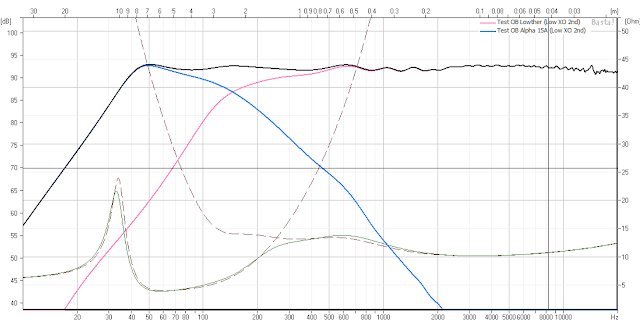- Got myself an Fiio X3 Gen2 for travelling. This has been pretty good, but I have not been very happy with its pairing with my Earsonics. I am still awaiting my LH Geek Wave...
- Received the LH Geek Out SFi. I think I got it correct. It has been pretty good overall.
- Purchased and built the Elekit TU-8300R. Been fantastic Running them in with JJ 300B, Siemens ECC801s and James output transformers. Enjoying it and dreaming of upgrading it Elrog 300B and Noguchi Finemet output transformers.
- Built (finally) an OB with my Lowther DX3. Really enjoying them, but lacking bass. Which leads into the main contents of this post.
So, it took me all of 2 hours to build the OB for the Lowther, it was made using 16mm MDF, and tilted back 10 degrees with the baffle 450mm wide and 900mm high. It is nothing special. But the music that it makes is great, and really focused me on finishing these OB. I was reminded that I got the Lowther and Alpha 15a in 2011... Anyway, I started doing some simulations in Basta and got three working concepts. The three concepts are:
- Passive first order crossover.
- Passive second order crossover.
- Active second order crossover.
Overall, I got the three options to look relatively similar in simulation. Note that all T/S data is by the manufacturer's supplied data and not through any measurement. I have also provided a fourth option using a higher crossover point using 1st order - this was done to keep values low and to use the crossover point to tame the baffle step, and obviate the need for a BSC. See the last option below.
Passive 1st order crossover
The parameters for this design are:
Lowther DX3
Crossover 68 uF
BSC 4R, 68 uF and 1.2 mH
L-pad of 8R
Eminence Alpha 15A
Crossover at 8 mH
'Room Gain' turned on with default settings.
 |
| Frequency response for passive 1st order crossover |
Passive 2nd order crossover
The parameters for this design are:
Lowther DX3
Crossover 68 uF and 12 mH
BSC 3R, 68 uF and 1.2 mH
L-pad of 2R
Eminence Alpha 15A
Crossover at 10 mH and 200 uF
'Room Gain' turned on with default settings.
Reversed polarity.
 |
| Frequency response for passive 2nd order crossover. |
Active 2nd order crossover
The parameters for this design are: The source voltage has been modified to allow for a 'flat' frequency response.
Lowther DX3
Voltage set at 2.83 V
2nd order at 250 Hz Q=0.707
BSC 4R, 68 uF and 1.2 mH
Eminence Alpha 15A
2nd order at 150 Hz Q=0.707
Voltage set at 5 V
'Room Gain' turned on with default settings.
 |
| Frequency response for active 2nd order crossover |
Passive 1st order crossover (high crossover point)

Creo que un sistema OB + Lowther sigue valiendo la pena si estás dispuesto a invertir tiempo, espacio y diseño. Tiene un carácter muy especial — naturalidad, escena abierta, musicalidad — que pocos diseños modernos igualan. Encuentra las tuyas en cityclub
ReplyDelete